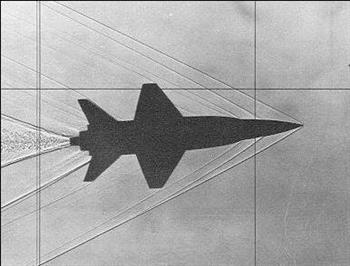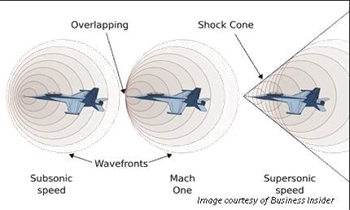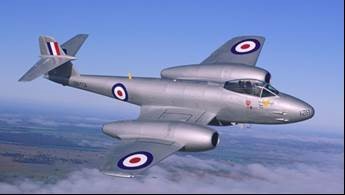Aerospace Micro-Lesson #71
In This Section
Chuck Yeager and the Sound Barrier
Seventy years ago, the world was entering a new era: the dawn of the jet age. Test pilots and engineers around the world were on the edge of a new frontier of flight, as daring aviators strapped themselves into untested (and often dangerous) aircraft in a constant competition to fly higher and faster using these new technologies. Dozens of engineers and pilots made these bold exploits possible, but one man came to symbolize better than any the spirit of the age - Charles E. “Chuck” Yeager, a World War II fighter ace and United States Air Force test pilot. On October 14, 1947, Yeager became the first human being to travel faster than the speed of sound. Flying a tiny orange rocket plane called the Bell X-1, he broke the sound barrier and helped usher in one of the most exciting periods in aerospace history.
GRADES K–2
Who was Chuck Yeager, and why do people care about him? Chuck Yeager is a pilot, who during his career became one of the most successful and important airmen who have ever lived. Yeager first flew as a fighter pilot in World War II, where he and his fellow airmen were charged with attacking enemy aircraft and defending American forces in Europe. Yeager was a very successful pilot who survived being shot down over enemy territory to become a fighter ace.
World War II was a huge conflict that caused a lot of damage and destruction to countries around the world. However, it also forced scientists and engineers to develop many new technologies, including jet engines and rocket engines. After the war, these same scientists and engineers kept working on these machines; different countries competed with each other to see who could develop the best aircraft and weapons. The United States, with its big factories and workers returning from the war, was at the forefront of this race. The Air Force spent a lot of time and money building faster and faster planes in an attempt to travel faster than sound itself. A lot of pilots lost their lives trying to break the so-called “sound barrier” because traveling that quickly is very difficult. However, in 1947, Chuck Yeager became the first person to go faster than the speed of sound—instantly making him an aviation icon and an American hero.
Chuck Yeager continued to serve in the Air Force long after his record-breaking Mach 1 flight. He went on to test several other experimental aircraft and to command aircraft in both the Korean and Vietnam wars.
Suggested Activity: There is a very short YouTube video of Chuck Yeager and the X-1 which your class might watch: youtube.com/watch?v=2-mXNPhTdtk.
GRADES 3–5
Chuck Yeager is best known for being the first person proven to have broken the sound barrier. You may have heard of the sound barrier, sonic booms, or the term “supersonic,” but what do these terms mean? Well, as you might know, sound travels at a certain speed. When you are talking to someone or listening to music, you don’t notice this because sound travels so quickly that it seems instantaneous. But have you ever tried talking to someone across a big distance, like a football field? If you pay close attention, you can see that someone’s mouth will move before you start to hear his words. This is because light (which lets you see someone) travels much more quickly than sound (which lets you hear someone). This is the same reason that in a thunderstorm, lightning always “arrives” before the thunder. In normal air, sound travels at 344 meters per second (or about 770 miles per hour). That’s pretty fast–most cars can only travel at around 50 meters per second (and the speed limit on interstate highways is only 31.3 meters per second) and even an airliner can only reach about 250 meters per second.
As you might imagine, flying faster than the speed of sound (or supersonically) is very difficult. When pilots first started flying close to the speed of sound during and after World War II, it seemed impossible to go faster. Strange things started happening as they got near Mach 1 (or one times the speed of sound): planes would start falling apart, controls would stop working, and other dangerous and unexplained phenomena made flying faster than the speed of sound seem impossible. For this reason, pilots started talking about an unbreakable “sound barrier” that prevented planes from flying faster.
In reality, what happens as aircraft approach the speed of sound is that waves form around the vehicle. We don’t often think of air as having much substance, but it is a fluid like water—and like water, it is possible for waves to form in it. A good way to think about supersonic airplanes is to imagine a boat. As the boat moves, it pushes water out of the way. As the boat moves more and more quickly, it has to push more and more water out of the way. Eventually, the water “piles up” and forms a wave in front of the boat. This makes it difficult for the boat to go any faster—but with enough power, a speedboat can jump up on top of this wave and go even more quickly. The same thing happens with airplanes: near Mach 1, a shockwave forms in front of the plane, which requires a lot of thrust to break through. Look at the picture of an X-15 rocket plane and see the shockwaves coming off of different parts of the plane, much like the bow wave in front of a boat.
Chuck Yeager proved that it is in fact possible to go more quickly than the speed of sound, with a short flight in the rocket-propelled Bell X-1 in 1947. We now have a good understanding of how supersonic airflows behave and how they affect aircraft, so building supersonic vehicles is not quite as daunting as it once seemed. Pilots have been flying past Mach 1–to Mach 2, 3, 4 and even up to Mach 6–ever since Chuck Yeager’s famous flight in 1947. Astronauts returning from space fly at even higher Mach numbers as they re-enter the Earth’s atmosphere and slow down.
Suggested Activity: Have students stand at opposite ends of a large field – get them as far apart as possible. Demonstrate how the sound takes time to travel between the students by having them communicate. For comparison, you could have a “control” group of students communicate using light (hand signals, waving flags, flashlights, mirrors, etc.). Alternatively, the students could stand 100-200 feet from the side of a building in an open field and listen to the echo off the building’s wall when you fire a starting pistol.
You may want to watch this video clip or something similar with your class, to let them hear the sound of a sonic boom as well as reviewing the information on what causes it: youtube.com/watch?v=-d9A2oq1N38
GRADES 6–8
On October 14, 1947, Chuck Yeager became the first person to exceed the speed of sound in level flight. In doing so, he (and the team of engineers and pilots who had built and tested his aircraft, the Bell X-1) proved wrong decades of conventional aeronautical wisdom, which purported that human beings couldn’t physically travel faster than the speed of sound. Scientists have known since the 1800s that in normal air, sound travels at 344 meters per second (or 770 miles per hour). For comparison, most cars can only travel at around 50 meters per second, and even an airliner can only reach about 250 meters per second.
As you might imagine, flying faster than the speed of sound (or supersonically) is very difficult. When pilots first started flying close to the speed of sound during and after World War II, it seemed impossible to go faster. Strange things started happening as they got near Mach 1 (or one times the speed of sound): planes would start falling apart, controls would stop working, and other dangerous and unexplained phenomena made flying faster than the speed of sound seem impossible. For this reason, pilots started talking about an unbreakable “sound barrier” that prevented planes from flying faster. Some physicians even thought that human beings were medically unfit to travel faster than the speed of sound. Luckily, thanks to Chuck Yeager and many other brave test pilots who pushed the boundaries of human flight, we now know that that’s not true. In fact, we have learned a lot about how aircraft fly faster than the speed of sound and the physics of supersonic flight. One key part of supersonic flight which you might have heard of is the “sonic boom”.
What is a sonic boom, exactly? A sonic boom is a pressure wave felt on the ground as a supersonic vehicle passes overhead. These waves form as the vehicle pushes air out of its way. Another way to describe this is to say that the vehicle produces disturbances which move away from the plane in all directions. These disturbances are basically sound waves—regions where the air is being pushed together (compressed). Since they are sound waves, they move at about the speed of sound—and when the vehicle (whether it’s an aircraft, a spacecraft, or even a car) moves more quickly than the speed of sound, it leaves these waves behind it. Think of a supersonic plane moving through the air like a fast speedboat moving through the water. The boat creates a big wave by moving through the water, and effectively rides on top of this wave, rising slightly out of the water. In other words, the disturbance produced by the boat (the wave) moves more slowly than the boat itself, so an observer in the water wouldn’t know or feel the boat passing by until the wave behind it (the wake) passed as well. This is effectively what happens with supersonic flight: the airplane produces a sort of “wake” which follows the plane as it flies. If a supersonic jet flew overhead, you wouldn’t hear it until it had already gone by—at which point you’d be hit by the sonic boom.
Many people think of a sonic boom as an event that happens for a single moment when a jet reaches supersonic speed; certainly, this fits with the idea of “breaking” the sound barrier that many people still have. But from what we have already learned, you should know that this is not the case: a sonic boom is a continuous phenomenon that goes on for as long as a plane is flying faster than the speed of sound. The same bow wave phenomenon that we observe in fast boats holds true for the plane, with the shockwaves produced by the plane trailing off behind it. When these shockwaves pass over a point on the ground, that is where the people there hear or feel a sonic boom. For this reason, supersonic aircraft aren’t allowed to fly over most countries—because the shockwaves they produce in the form of sonic boom follow them, possibly creating massive damage to property on the ground.
GRADES 9–12
Chuck Yeager’s first verified flight of a supersonic aircraft on October 14, 1947 kicked off a new period in the history of aviation: the jet age. Although jet aircraft had been built as early as 1939, it was the development of supersonic jets almost a decade later that would fundamentally change the design of aircraft into the sleek, high-speed designs that have dominated the latter half of the 20th century and beyond.
Compare the two jet aircraft shown on the next page—the Gloster Meteor and the F-100 Super Sabre. These two airplanes first flew just ten years apart–in 1943 and 1953, respectively–but their designs are worlds apart.
We tend to think of sleek, pointy designs like the Super Sabre as being naturally faster, but why is that? Why must supersonic aircraft be designed differently? Answering that question—and figuring out the necessary design features for these new, high-speed aircraft—was a key objective of aeronautical engineers in the 1940s and test pilots like Chuck Yeager.
One of the biggest issues faced by supersonic aircraft is the formation of undesirable shockwaves. As you can read in the above sections, shockwaves form when pressure disturbances around an aircraft “pile up” like the bow wave in front of a boat. In reality, shock waves are generated by multiple parts of an aircraft—any place where the airflow hits an obstruction at supersonic speed. Some propeller-driven aircraft even faced issues created by shockwaves forming at the tips of their propellers because they spun at such high speeds. Shockwaves have a negative effect on aircraft because they create a lot of extra air resistance, because they tend to cause vibrations, and because they change the behavior of airflows in ways that even today, 80 years after they were discovered, scientists still don’t fully understand.
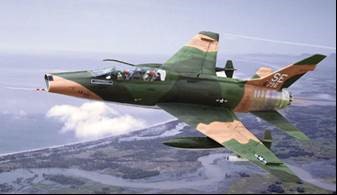 Most supersonic aircraft (especially in the early days of high-speed flight) were designed to avoid shockwaves as much as possible. British engineers working on their own supersonic aircraft—the Miles M.52—designed it in the shape of a bullet, correctly theorizing that the pointy shape would allow it to “pierce” the sound barrier. They gave the plane a sharp nose and tiny stubby wings, key design elements which would be picked up by the American engineers who designed Chuck Yeager’s Bell X-1. This shape allows the important parts of the plane—particularly the wingtips—to remain clear of the shockwave formed at the nose; since the wings are stubby, they do not extend far out enough to be “hit” by the shock, which trails from the pointed nose like the wake from a boat.
Most supersonic aircraft (especially in the early days of high-speed flight) were designed to avoid shockwaves as much as possible. British engineers working on their own supersonic aircraft—the Miles M.52—designed it in the shape of a bullet, correctly theorizing that the pointy shape would allow it to “pierce” the sound barrier. They gave the plane a sharp nose and tiny stubby wings, key design elements which would be picked up by the American engineers who designed Chuck Yeager’s Bell X-1. This shape allows the important parts of the plane—particularly the wingtips—to remain clear of the shockwave formed at the nose; since the wings are stubby, they do not extend far out enough to be “hit” by the shock, which trails from the pointed nose like the wake from a boat.
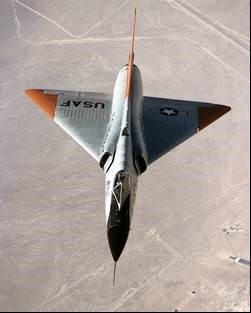
One of the most interesting design features of supersonic aircraft is a little bit more subtle. It’s called “area ruling” and it describes how designers shape aircraft according to the so-called “area rule”. Pilots of early supersonic planes—including Chuck Yeager—experienced a huge increase in aerodynamic drag as they got close to the sound barrier. This is because the air flowing around their planes accelerated as it was deflected by the surfaces of the aircraft, briefly achieving supersonic velocity and forming shockwaves. As mentioned above, these shockwaves produced additional drag which slowed the planes down and in some cases made it impossible for them to go supersonic. Engineers realized that the way to prevent this so-called “wave drag” was to minimize the amount of deflection and acceleration experienced by air flowing over their aircraft. They did this by keeping the area profile (i.e. the amount of air which had to be deflected for the plane to pass through) as smooth and constant as they could. The pointy nose of a plane didn’t have much area to deal with, but creative solutions were needed to decrease the cross-sectional area where the (relatively) large wings joined the fuselage. The solution was to “pinch” the fuselage where the wings attached, creating a distinctive “coke bottle” shape (see the picture of a Convair Delta Dart as an example). This “pinched” fuselage meant that the overall area increase at the wing root was decreased, minimizing the flow deflection and decreasing wave drag. Nowadays, most supersonic aircraft incorporate this important design feature which allows them to efficiently cruise at supersonic velocities.
Sixty Years Ago in the Space Race:


